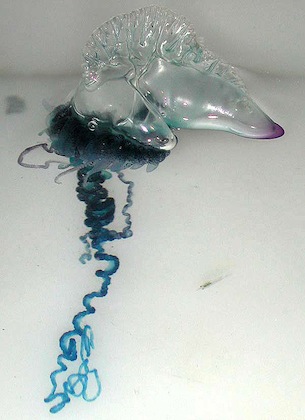When it comes to getting along, we could all take a lesson from the Portuguese man-of-war. Despite its fearsome sting, it’s really a “let’s-all-get-along” kind of creature. That’s because it’s really a cooperative — a collection of several different organisms that come together to make a single critter.

All of them are known as polyps or zooids. They’re all highly specialized — they do one thing, and they do it quite well.
One of them forms the float — a gasbag a few inches long that floats atop the water. It’s what gives the man-of-war its name — it resembles an old Portuguese warship with its sails aloft. Floats come in two varieties — those that lean to the left, and those that lean to the right. The two varieties are pushed in different directions by the wind, allowing the species to spread out across the oceans.
Another type of polyp forms the structures that give the man-of-war its fearsome reputation: tentacles lined with barbed stingers. When they brush across possible prey or predators, the stingers inject a powerful toxin. It paralyzes prey, and gives enemies an unpleasant shock. These cells can work even when the organism looks dead and dried out on the beach, so it’s best to leave them alone.
A third type of polyp forms another set of tentacles, which pull prey up into the man-of-war’s stomach at the bottom of the float. And yet another type of polyp is specialized for reproduction — making more Portuguese man-of-wars to float along the world’s oceans.
This episode of Science and the Sea was made possible by Texas Sea Grant.

